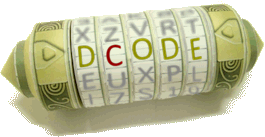Tool to encode and decode text in Bubble Babble code, transform your data into secure text fingerprints and easily decrypt them online.
Bubble Babble Code - dCode
Tag(s) : Character Encoding
dCode is free and its tools are a valuable help in games, maths, geocaching, puzzles and problems to solve every day!
A suggestion ? a feedback ? a bug ? an idea ? Write to dCode!
Bubble Babble Code
Bubble Babble Decoder
Bubble Babble Encoder
Answers to Questions (FAQ)
What is Bubble Babble? (Definition)
Bubble Babble is an encoding format invented to represent digital data (hash, keys, binary data) as pseudo-words that are easy to read, pronounce, and remember. Each encoded string resembles a sequence of syllables that don't correspond to real words but are easy to read, dictate, and verify.
Example: xinag-fyryk-gunux is the encoding of dCode
How to encode using Bubble Babble?
Encoding with Bubble Babble involves transforming binary data into a sequence of syllables forming phonetic pseudo-words.
Split into 2-byte blocks. If the length is odd, add a null byte (0x00).
Transform each block into 5 letters using a bit-shift and modulo mechanism.
— Vowel v1: The leftmost 2 bits of the first byte + checksum, all modulo 6.
— Consonant c1: The next 4 bits of the first byte.
— Vowel v2: The last 2 (rightmost) bits of the first byte + the integer part of the checksum divided by 6, all modulo 6.
— Consonant c2: The leftmost 4 bits of the second byte.
— Consonant c3: The rightmost 4 bits of the second byte.
The six vowels are aeiouy (values from 0 to 5) and the consonants are limited to 17: bcdfghklmnprstvz (values from 0 to 15) and the letter x (denoted 16).
The checksum is initialized to 1 and three letters are appended to the end to store its value.
Add x to the beginning and end to denote the string.
Join the letters with a hyphen separator - every 5 characters.
How to decrypt Bubble Babble cipher?
Decoding with Bubble Babble involves reversing the process: taking a string in Bubble Babble format and converting it back to binary data.
The first step is to remove the initial x and the final x, then split the string into groups of five letters.
From the vowels v1 and v2 and the three consonants c1, c2, and c3, to reconstruct the first byte, retrieve the numerical values associated with the letters.
The first two bits (on the left) are ((v1 - checksum) % 6 + 6) % 6
The middle four bits are encoded with c1.
The last two bits (on the right) are ((v2 - floor(checksum / 6)) % 6 + 6) % 6
To reconstruct the second byte, the leftmost four bits come from c2 and the rightmost four bits come from c3.
How to recognize a Bubble Babble ciphertext? (Identification)
Recognizing Bubble Babble is done by observing certain characteristics:
— Strings begin and end with the letter x.
— The default structure is based on groups of 5 characters separated by a hyphen.
— The character groups are formed by alternating consonants and vowels: consonant, vowel, consonant, vowel, consonant (which makes them easy to pronounce).
What are the variants ofBubble Babble?
Bubble Babble doesn't really have any official variants.
However, it is possible to do away with hyphens and use uppercase or lowercase letters interchangeably.
A similar phonetic encoding could be the PGP Word List.
When was Bubble Babble invented?
BubbleBabble was defined in 2000 by Antti Huima, as part of the SSH project here
The goal was to allow the user to visually verify public key fingerprints while avoiding errors in typing or reading hexadecimal strings.
Source code
dCode retains ownership of the "Bubble Babble Code" source code. Any algorithm for the "Bubble Babble Code" algorithm, applet or snippet or script (converter, solver, encryption / decryption, encoding / decoding, ciphering / deciphering, breaker, translator), or any "Bubble Babble Code" functions (calculate, convert, solve, decrypt / encrypt, decipher / cipher, decode / encode, translate) written in any informatic language (Python, Java, PHP, C#, Javascript, Matlab, etc.) or any database download or API access for "Bubble Babble Code" or any other element are not public (except explicit open source licence). Same with the download for offline use on PC, mobile, tablet, iPhone or Android app.
Reminder: dCode is an educational and teaching resource, accessible online for free and for everyone.
Cite dCode
The content of the page "Bubble Babble Code" and its results may be freely copied and reused, including for commercial purposes, provided that dCode.fr is cited as the source (Creative Commons CC-BY free distribution license).
Exporting the results is free and can be done simply by clicking on the export icons ⤓ (.csv or .txt format) or ⧉ (copy and paste).
To cite dCode.fr on another website, use the link:
In a scientific article or book, the recommended bibliographic citation is: Bubble Babble Code on dCode.fr [online website], retrieved on 2025-11-18,
